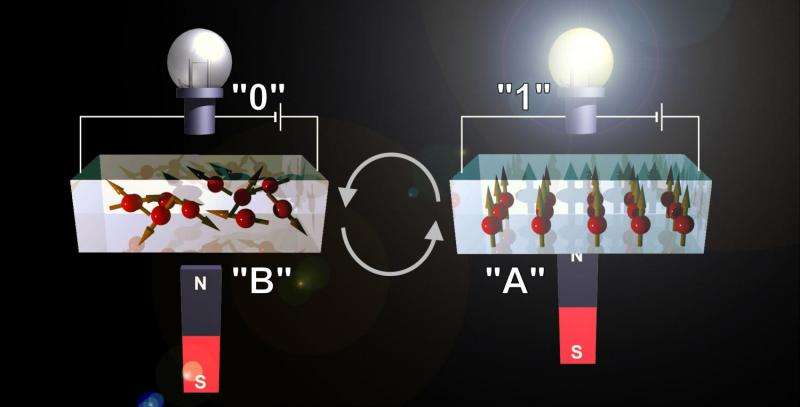The switch that could double USB memory

Scientists at Hokkaido University have developed a device that employs both magnetic and electronic signals, which could provide twice the storage capacity of conventional memory devices, such as USB flash drives.
Conventional USB flash drives are electronic data storage devices. They store information by using millions of small gates that process information into "words" consisting of various combinations of the numbers 0 and 1.
A team of scientists at Hokkaido University's Research Institute for Electronic Science investigated the possibility of using a magnetic signal along with the electronic signal to allow double the storage capacity in these "multiplex writing/reading" devices. In addition to the binary 0/1 method of storing information, this would add an A/B store for the information as well. To do this would require finding a material that can switch back and forth from a magnet to a non-magnet state.
The team investigated two forms of strontium cobalt oxide (SrCoOx): one is an insulating non-magnet while the other is a metal magnet. By changing the oxygen content in this compound, the team could cause it to switch between the two forms. However, the two methods currently available to do this have big drawbacks. One method requires using a high temperature heat treatment. This would make it impossible to use in devices that work at room temperature, such as your mobile phone. The other method involves using a dangerous alkaline solution. This would require a device that is sealed so that the solution does not leak. This method is difficult to miniaturize and is thus not suitable for information storage devices.
The team developed a new method to use strontium cobalt oxide safely at room temperature in air. They applied a sodium tantalate thin film, which can be used at room temperature without leaking alkaline solution, over layers of strontium cobalt oxide. When a three-volt current was applied (or about one-seventh of the voltage required in currently available USB flash drives), the insulating form of SrCoO2.5 reversibly switched to its metal magnet form, SrCoO3, in three seconds. By comparison, current devices can store information in 0.01 seconds. Making the device smaller would shorten the time needed for the compound to switch between an insulator and a magnet, the researchers say. This would allow the storage of an even larger number of photos and videos in mobile phones, for example.
More information: Takayoshi Katase et al. Reversibly Switchable Electromagnetic Device with Leakage-Free Electrolyte, Advanced Electronic Materials (2016). DOI: 10.1002/aelm.201600044
Provided by ResearchSEA



















